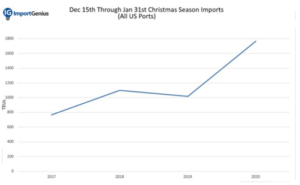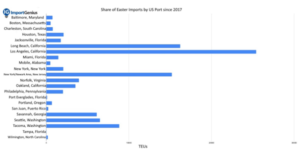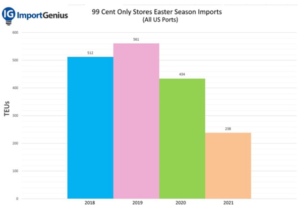As Eastern approaches importers still suffering X-mas delays
Christmas trees should be packed away by now, but U.S. importers may still be waiting for their holiday packages — and the impact likely will be felt for another big holiday: Easter.
Historic volumes at the nation’s ports have knotted the flow of trade so badly that containers filled with December’s holiday items still are being processed through the ports, according to data and analysis from ImportGenius.
“Based on the analysis of roughly 75,000 U.S. import records from August 2017 to present, which we identified as related to Christmas, it is very clear that the shipping snarl resulted in a significant deviation from the traditional Christmas import schedule,” said William George, analyst at ImportGenius.
Data analysis project new delays for Eastern period
“November imports in 2020 were at the highest level seen over the past four years and were nearly double the values we found for 2017 and 2019. January imports are also double or nearly triple the volumes we’ve seen for past years, which suggests that a lot of people’s shipments were literally too late for Christmas.”
George warned: “The delays visible in the Christmas data, and the trends already evident in our Easter data, strongly suggest that Easter imports as a whole will be similarly impacted.”
These late shipments in the end will eat into the gross margins of retailers. American Shipper shared the findings with the National Retail Federation.
Retailer industry face critical delays
“Retailers want their cargo as soon as they can get it,” said Matthew Shay, CEO of the National Retail Federation. “This is critically important for all retailers, and especially important for retailers that were forced to close their stores temporarily when the pandemic first hit.
Having stores open now and fully stocked will help support economic recovery for retailers and will provide customers with access to the goods they need.
“No retailer wants to have empty shelves or have to put items they receive late immediately on discount. These added costs of the delays ultimately have to be absorbed by the retailer.”
Through deeper analysis, the spike of containers processed during the Dec. 15-Jan. 31 timeframe compared to 2017, 2018 and 2019 shows an incredible increase.
X-mass products in January are causing issues for retailers
Even if a container were processed on Dec. 15, it’s highly unlikely those products would make it to a retailer’s shelf in time for Christmas. If they did, the products would not be listed at full price.
The ripple effect of this slowdown shows the retail industry’s unrealized profits. Bottom line: The profits could have been higher.
“We are still seeing Christmas decor and products coming in,” said Brett Rose, CEO of United National Consumer Suppliers. “Unless a retailer has the ability to pack it away, they are forced to dump it into the off-price market at a huge discount. We are seeing an influx of Christmas product available.”
The Port of Los Angeles is ground zero for the congestion and delays. While there are many compounding reasons behind the container bottleneck, there is at least one issue that can be addressed and fixed — the vaccination of the supply chain.
Shortage of longshore workers in California disturbs the supply chain
The state of California did not put longshoremen and truckers in the “essential worker” category for vaccinations. Currently, the human element of the supply chain, arguably the most important in moving out the containers, is not working at full capacity.
“With the supply chain severely strained, it’s critical that our longshore workers be vaccinated immediately,” said Port of Los Angeles Executive Director Gene Seroka. “I, along with other maritime leaders, have been advocating for this since early December.
“Unfortunately, we now have more than 800 Southern California dockworkers staying home due to COVID. These workers have answered the bell every day since this pandemic began, moving goods to each of our 435 congressional districts. We are overdue to make this happen.”
For the flow of trade to be healthy, you need all pieces of the puzzle to be in good physical shape. While the U.S. landlord ports have no control over the efficiencies of the terminals and carriers, vaccination is something that can be managed.
Vaccination of work force is vital in near future
“We know there are many issues impacting port operations today, including an essential workforce impacted by COVID-19, equipment availability and a stressed system,” Shay said. “First and foremost, we need to ensure the supply chain workforce, including longshoremen and drivers, has access to quickly get vaccinated and safely keep the nation’s commerce moving. Their access to the vaccine is critical to our economic recovery.”
While support for the vaccination of these men and women goes as high up as the Federal Maritime Commission, without the Biden administration stepping in, the risk to the supply chain continues.
As a result, supply chain management has never been more important for importers. The race for delivery has vessels either making the Port of Oakland their first stop to avoid the congested Port of Los Angeles, or importers selecting vessels destined for the East Coast ports.
Retailers looking to ship via Oakland thus avoiding delays
“The container ports along the East Coast are booming with the e-commerce surge,” said Bill Doyle, executive director at Maryland Port Administration. “Retailers, freight forwarders and BCOs are making the decision to avoid the congestion along the West Coast and are booking on ships that are traveling through the Panama Canal. Since July 16, we have had 11 new ships arrive into our port. We have unloaded approximately … 18,674 TEUs.”
In an interview with CNBC, Peloton CEO John Foley explained the company’s response to the delays. “With the last couple of months with the congestion at the ports, we’ve had to reschedule some members’ bike and treadmill deliveries. That is frustrating to them and that’s frustrating to us.”
The company recently announced it invested $100 million into expedited shipping to help alleviate the delays. “If one member gets a reschedule, that is one reschedule too many for our taste,” the company stated.
But the added expense for “faster” shipping does not guarantee a speedy delivery because of the port congestion.
Retailers looking for alternative gateways
“We continue to talk to our members and government officials about the ongoing issues at the ports, the impact these issues are having on the retail industry and ways to help address the congestion,” Shay explained. “Retailers continue to work with their transportation providers to find solutions to quickly move cargo that is currently sitting at ports, while also exploring alternate gateways.”
The next retail holiday that is seeing supply constraints is Easter. While February is not fully compiled, it is clear imports for the Easter holiday are behind, even compared to pre-trade war levels where frontloading was not part of the supply equation.
These interruptions can be a boon for some. United National Consumer Suppliers, which is a distributor from everyday consumer products to specialty items, is no stranger to helping retailers add to their shelves. Rose added his company is fielding requests from supermarkets to supplement their Easter products this year. “No retailer wants to have empty shelves.”
Analysing the trade data of Albertsons, Easter imports are off their historic levels.
With a struggling economy, dollar stores may be a popular destination for consumers to buy Easter products. While the chain has the ability to store product for those familiar with the company, Easter imports are way down from its historic levels. (99-Cent Only Stores and Albertson’s did not respond to a request for comment.)
Concerns are rising already for the summer season
This congestion in the supply chain shows no signs of changing anytime soon. China’s slowdown in the feeder service, which started in December, will exacerbate the congestion. Once that integral maritime route reopens, there will be an artificial surge of containers in March/April. The plug in the container system has some retailers fast tracking their domestic back-to-school orders.
“We started receiving orders for back-to-school items in January,” Rose said. “Normally we have retailers reaching out in June.”
The pandemic buying habits of the consumer are the accelerants on this container inferno, and they have Rose concerned about the supply of summer merchandise.
Delicate balance of supply and demand needs solutions
“With everyone home last summer, the pandemic buying of outdoor products depleted a lot of inventory,” he said. “Now with these delays, you could see a slowdown in the supply chain replenishment in patio furniture, fire pits and other outdoor items for this summer season.”
Shay added the supply chain disruption is an ongoing issue for retailers as they manage to meet consumer demand. “The bottlenecks and congestion we are seeing at our ports, both on the water and in the terminal, highlight the need for a truly 21st century supply chain that can handle these issues.”
The delicate balance of supply and demand has been off kilter since the pandemic started. By the tale of the containers, it doesn’t look like this balance is coming back anytime soon.







